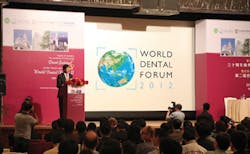Dentistry Around the World
by Patrick Tessier, President & CEO at Modern Dental Laboratory USA
Every two years, Modern Dental Laboratory organizes an international educational event called the World Dental Forum. The 2012 event was recently held in Hong Kong in conjunction with the 30th anniversary of the University of Hong Kong Faculty of Dentistry. It was a well-attended function with over 500 clinicians from Europe, Australia, China, Hong Kong, Canada, and the United States. The branches of Modern from France, Germany, Netherlands, and Australia joined our American delegation for a discussion of dentistry and the business of dentistry.
Since Modern Dental Laboratory USA is the U.S. branch, we get a unique and inside view of dentistry from our international counterparts. As many of the Dental Economic readers are aware, the business of dentistry is practiced much differently outside the United States. Many American dentists and associated suppliers ask us for information as to what is happening overseas. Here are a few tidbits.
From the Patient Perspective
In the United States, the patient receives a bill for treatment from the dentist that includes all component costs, the dentist, assistant, supplies, and the lab bill. This allows the dentist to provide a simple single fee for a variety of treatments. It also allows the dentist to mark up the costs to provide profit, a very capitalistic organization to providing oral health care.
In most of Europe, Canada, and many other countries, the dentist provides two bills to the patient, one for the dental services and another for the lab bill. The fundamental distinction has been explained as a cultural belief that earning a profit on health care is unethical – that health care in general is a basic service that should be available to all citizens based on the actual cost, much like water, electricity, and sewer services. The government is the provider or overseer in most cases.
The differences in the basic structure to delivering oral health care in the United States versus the majority of the rest of the world have evolved our systems to much different results.
• In Europe and Canada, on average, there is one dentist for about every 1,500 people. In the United States and Australia, there is one dentist for every 2,000 people. So the American/Australian dentist is serving about 30 percent more people than their European counterparts.
• We are told that in Europe, particularly the Netherlands, the number of dentists is declining. Because the profit opportunity is more limited, the salaries are more modest. Therefore, dentistry as a profession is less desirable for the skilled professional.
• In Europe, labs sometimes market their products directly to the patient. For example, they offer discounts that the patient can bring to their dentist. Last time I was in Germany for the International Dental Symposium (IDS), our German partner had ads hanging from the subway handles.
• The cost of the lab products in Europe is much more price elastic than here in the U.S. Since the dentist does not actually pay for the prosthetic, and the patient accepts the choice of the dentist, prices for lab products can vary quite a bit. For example, if the lab woos the dentist with low cost CE golf excursions, they may be able to earn above market fees.
Taxes
Europe and Canada have long had tax systems that deliver more governmental tax revenues. Since the taxes also fund a large part of the dental services, for example, it is necessary. Even with the new Affordable Care Act, dentistry is almost a forgotten segment of health care in the United States.
One of the methods to collect more tax revenues is commonly known as the VAT tax. It allows a tax to be collected every time value is added to a product during the production and distribution all the way to the final consumer. In the United States, for the most part, wholesale transactions prior to the final sale to the consumer are not taxed. Exceptions in densely populated states, such as California and Illinois, exist. An example: in the state of Washington, our lab is not required to collect tax on products sold to dentists if the dentist is not the final consumer. California and Illinois do require labs to collect taxes for the same product.
Until now, there have been no federal taxes for dental lab products. But starting in 2013, a 2.3% federal tax for all dental product sales will be enacted. This means your lab bill will include a state tax (in some states) and the new federal tax. This is part of the funding for the Affordable Care Act.
Since the FDA does not distinguish in-office labs from commercial labs, states and the federal governments may seek to collect these taxes from dentists that manufacture medical devices in their office, i.e. Cerec and E4D.
These are just a few examples of how our systems differ from around the world. From the business perspective, we are quite different. From the clinical perspective we are much the same.
If you want to find out more on your own, think about attending a large international convention. The IDS, which is held every two years in Cologne, Germany, is a great one with over 100,000 visitors. The next convention is March 12-16, 2013. Another opportunity is the World Dental Forum, slated for Paris in 2014. Check our web site for more information at www.moderndentalusa.com.
Patrick Tessier, MBA, is the President & CEO of Modern Dental Laboratory USA.
Past DE Issues

